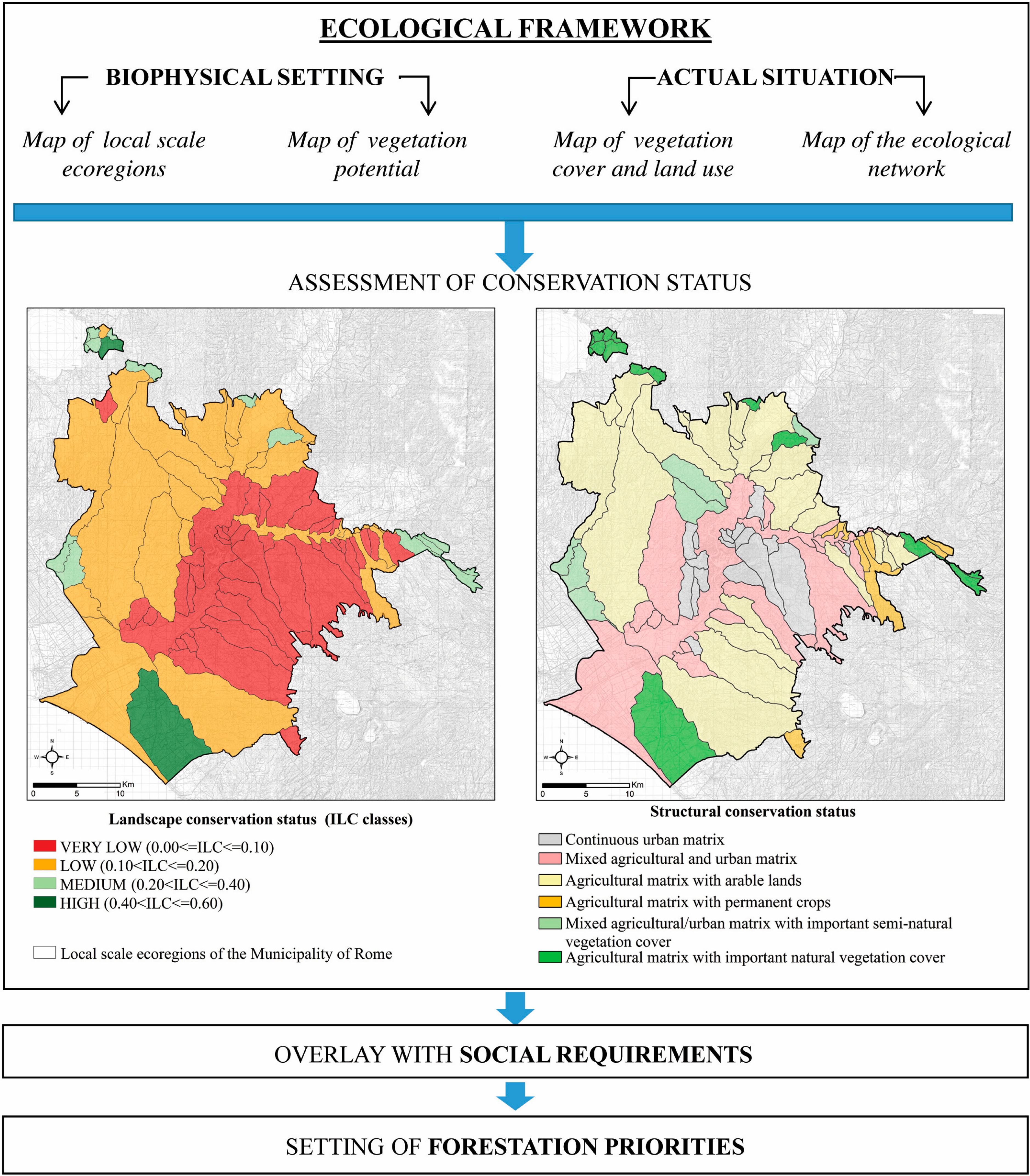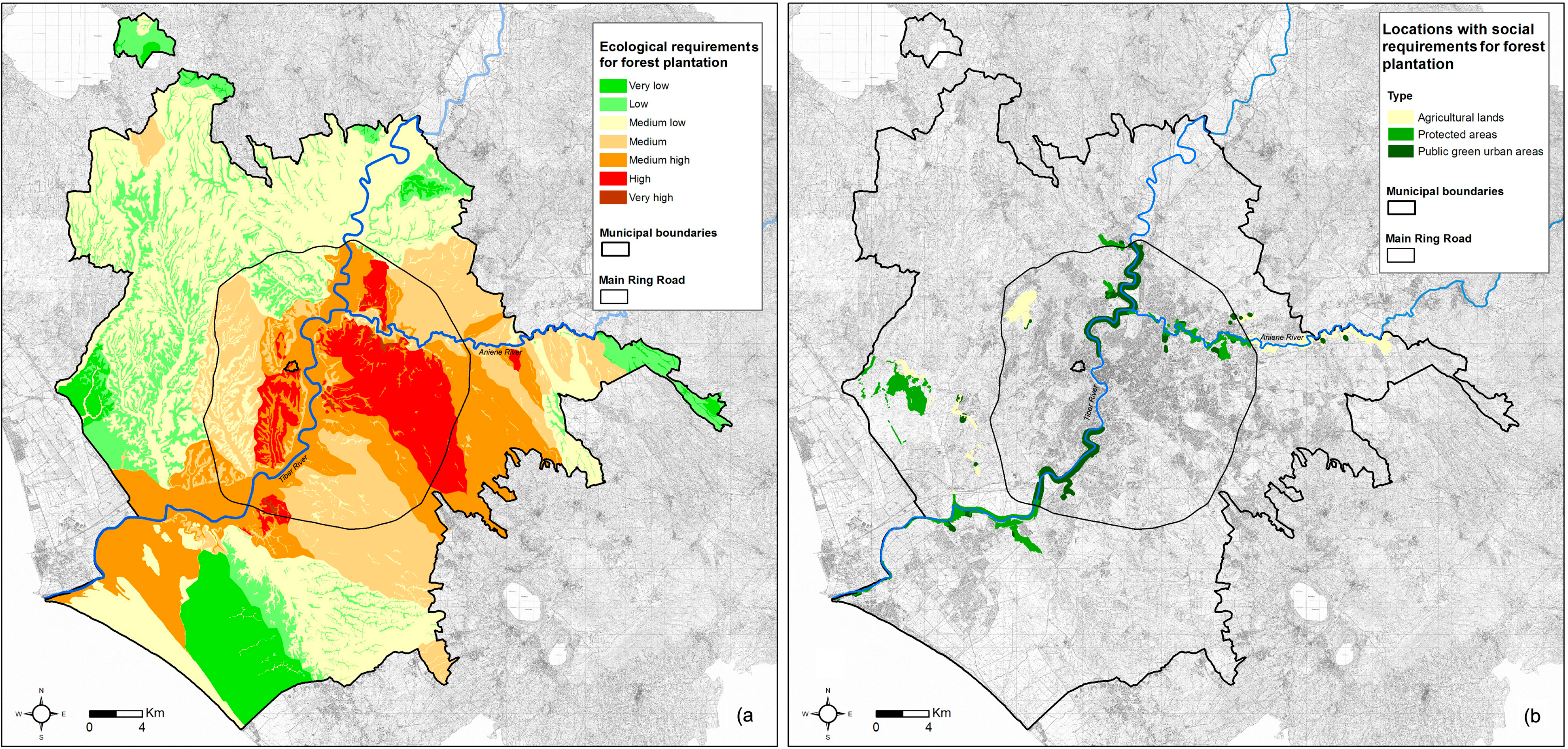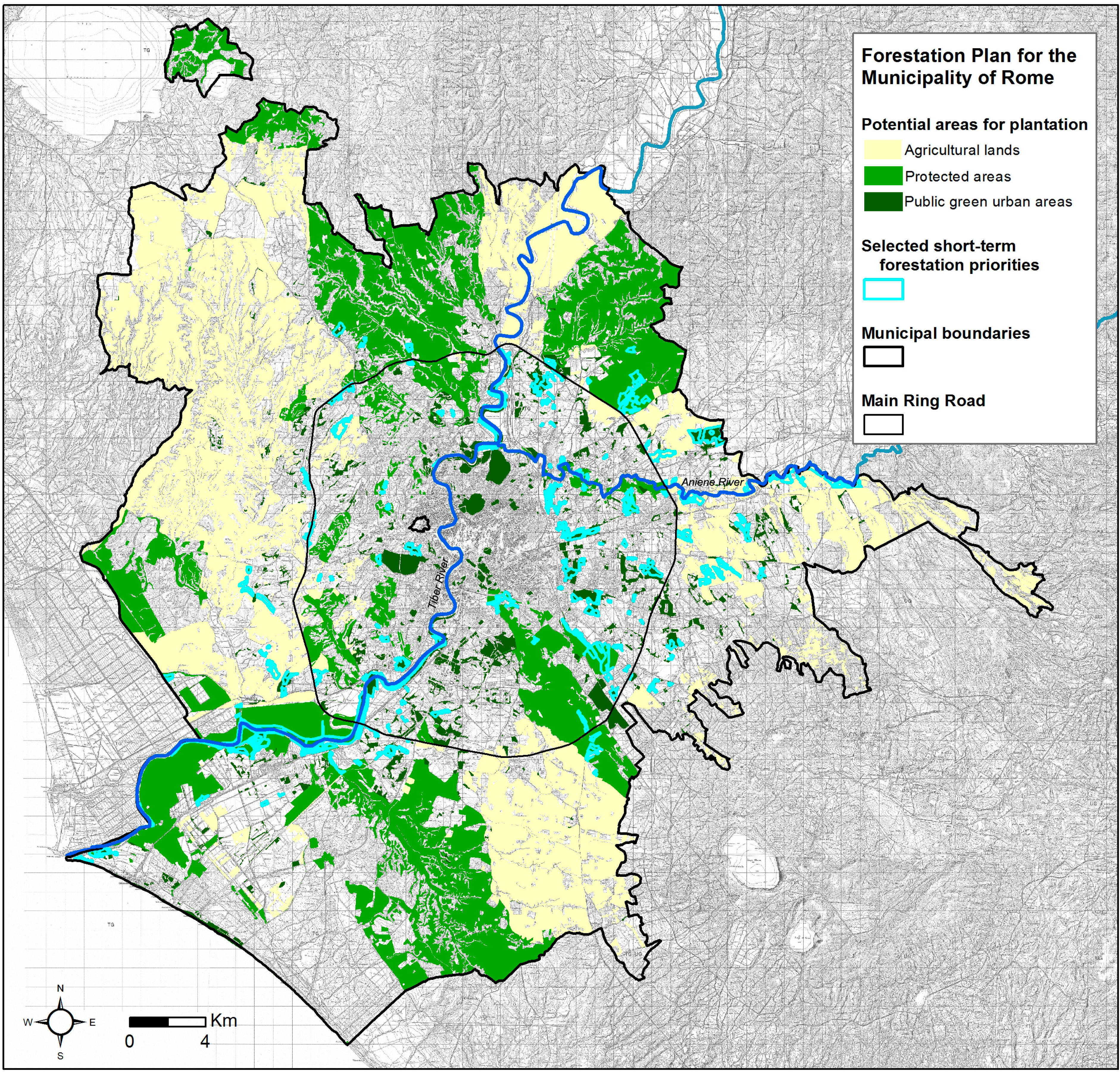Setting Priorities for Urban Forest Planning. A Comprehensive Response to Ecological and Social Needs for the Metropolitan Area of Rome (Italy)
Abstract
:1. Introduction
2. Selection of Priority Areas for Urban Forestation in the Municipality of Rome
2.1. Foundation of Forestation Planning in the Metropolitan Area of Rome

| Data | Basic information | Description | Utility for forestation planning |
|---|---|---|---|
| Vegetation cover and land use | Vegetation cover/land use map of Rome Municipality (scale 1:10,000) | Cartographic representation of 44 classes of present land cover/land use, derived from photo-interpretation of panchromatic aerial photographs taken in 2001; the fifth level of the hierarchical legend includes five physiognomic classes of native forests | Basic information on the extent and distribution of land cover/land use and vegetation types that allows: (i) selection of potential areas for forest plantation; (ii) assessment of present conservation status in relation to the potential land cover; (iii) estimation of actual forest cover; and (iv) assessment of fragmentation within different land units |
| Local scale ecoregions | Map of geomorpho-ecological units (catchment basins, alluvial plains, delta plain, and dune systems) of Rome Municipality (scale 1:50,000) [28] | Geographically defined and cohesive ecological units (ecoregions). They include portions of land with different vegetation potential but with functional connections (preferential exchange of species, matter and energy) and are characterized by a definite pattern of land cover and land use (landscape character) | Within these discrete and relatively wide areas of the Municipality, an assessment of the conservation status of the different types of natural and semi-natural vegetation is useful |
| Vegetation potential | Map of the environmental units/areas of pertinence of the vegetation series of Rome Municipality (scale 1:20,000) [38] | Typological units that can occur in different locations but display marked environmental homogeneity in terms of bioclimate, lithology and morphology; these units support 16 distinct types of vegetation potential (with possible different types of mature forest communities that share the same physiognomy) and related substitution communities | Environmental baseline that can be used to assess and monitor the effects of natural dynamics and human activities; reference model for selecting woody species to be planted [39] |
| Landscape conservation status | Map of landscape conservation status of the geomorpho-ecological units of Rome Municipality | Representation of the Index of Landscape Conservation (ILC) [40] for each of the local scale ecoregions. The ILC summarizes the environmental quality of land cover types in discrete land units according to the degree of soil sealing, impact of agricultural practices and distance of vegetation cover from the potential natural vegetation. The index varies between 0 (high level of artificialization) and 1 (high level of naturalness) | Identification of the urban and suburban sectors with markedly damaged environmental quality |
| Structural conservation status | Map of structural conservation status of the geomorpho-ecological units of Rome Municipality | Composition, prevalence and spatial arrangement of land cover types within each of the local scale ecoregions | Definition of the landscape matrix and the assessment of actual ecological connectivity for the discrete urban and suburban sectors |
| Public farms | Location of municipal farms and agricultural parks (provided by the Municipal Administration) | Public farms and agricultural parks committed to the development of social agriculture, creation of youth employment and inclusion of disabled people | Recognition of social priorities and opportunities for implementing biodiversity in agricultural areas |
| Degraded areas | Location of urban and suburban sectors affected by environmental degradation (provided by the Municipal Administration) | Areas in which more urban green space is needed, or air, soil and water quality needs to be improved | Identification of social priorities aimed at increasing accessible green spaces and improving environmental quality |
| Flood zones and areas for water resource management | Hydrogeological Structure Plan of the Tiber River basin (provided by the Municipal Administration) | Areas identified by the Basin Plan for sustainable use and management of water resources | Identification of priority areas for protection against floods and safeguard of water resources |
2.2. Criteria, Method and Basic Data for the Design of Forestation Ecological Framework
| Criteria | Parameters | Score |
|---|---|---|
| (1) Improvement of ecosystem representativity | Vegetation potential units with more than 10% of natural forests inside ecoregion boundaries | Not rated |
| Vegetation potential units with less than 10% of natural forests inside ecoregion boundaries | + (High requirement) | |
| Vegetation potential units with less than 10% of natural forests, semi-natural vegetation and green urban areas inside ecoregion boundaries | ++ (Very high requirement) | |
| Vegetation potential units without any natural forest, semi-natural vegetation or green urban area inside ecoregion boundaries | +++ (Critical requirement) | |
| (2) Restoration of landscape quality | Ecoregions with “medium” up to “high” landscape conservation status (ILC > 0.2) | Not rated |
| Ecoregions with “low” landscape conservation status (0.1 < ILC ≤ 0.2) | + (High requirement) | |
| Ecoregions with “very low” landscape conservation status (ILC ≤ 0.1) | ++ (Very high requirement) | |
| (3) Functional enhancement of the ecological network | Ecoregions with prevailing “agricultural landscape matrix” and/or “important natural/semi-natural vegetation cover” | Not rated |
| Ecoregions with “mixed urban/agricultural landscape matrix” | + (High requirement) | |
| Ecoregions with “urban landscape matrix” | ++ (Very high requirement) |
2.3. Criteria, Method and Basic Data for Setting Forestation Priorities
| Criteria | Parameters | Score |
|---|---|---|
| (4) Improvement of agriculture sustainability | Lands occupied by public farms | + (High requirement) |
| (5) Restoration of degraded urban and suburban sectors | Degraded neighborhoods or proximity to major pollution sources | +++ (Critical requirement) |
| (6) Safeguard of water resources and flood areas | Flood zones | + (High requirement) |
3. Results
3.1. Ecological Framework of the Forestation Plan for the Municipality of Rome
| Components of the master plan ecological network | Agricultural lands | Protected areas | Public green urban areas | Total (ha) |
|---|---|---|---|---|
| Total extent (ha) | 36,653 | 40,825 | 6861 | 84,339 |
| Potential areas for forest plantation according to suitable current land cover and minimum patch extent (ha) | 29,794 | 24,554 | 5319 | 59,667 |
| Potential areas for forest plantation within sectors with recognized ecological requirements (ha) | 29,300 | 22,590 | 5020 | 56,910 |
| Potential areas for forest plantation within or adjacent to locations with recognized social requirements (ha) | 870 | 1191 | 478 | 2539 |
| Priority areas for forest plantation with highest ecological and/or social requirements (ha) | 1791 | 6783 | 1128 | 9702 |
| Selected short-term forestation priorities (ha) | 373 | 1051 | 845 | 2269 |

3.2. Priority Areas for Forestation in the Municipality of Rome

4. Discussion
4.1. Expected Impact of the Forestation Plan for the Municipality of Rome at the Local Level
4.2. General Strength of the Forestation Plan for the Municipality of Rome
5. Conclusions
Acknowledgments
Author Contributions
Conflicts of Interest
References
- De Oliveira, J.A.P.; Balaban, O.; Doll, C.N.H.; Moreno-Penaranda, R.; Gasparatos, A.; Iossifova, D.; Suwa, A. Cities and biodiversity: Perspectives and governance challenges for implementing the convention on biological diversity (CBD) at the city level. Biol. Conserv. 2011, 144, 1302–1313. [Google Scholar] [CrossRef]
- Säynäjoki, E.; Heinonen, J.; Junnila, S. The Power of Urban Planning on Environmental Sustainability: A Focus Group Study in Finland. Sustainability 2014, 6, 6622–6643. [Google Scholar] [CrossRef]
- Schewenius, M.; McPhearson, T.; Elmqvist, T. Opportunities for Increasing Resilience and Sustainability of Urban Social–Ecological Systems: Insights from the URBES and the Cities and Biodiversity Outlook Projects. Ambio 2014, 43, 434–444. [Google Scholar] [CrossRef] [PubMed]
- Crane, P.; Kinzig, A. Nature in the Metropolis. Science 2005, 308. [Google Scholar] [CrossRef]
- McPherson, E.G. Urban forestry in North America. Renew. Resour. J. 2006, 24, 8–12. [Google Scholar]
- Dearborn, D.C.; Kark, S. Motivations for Conserving Urban Biodiversity. Conserv. Biol. 2009, 24, 432–440. [Google Scholar] [CrossRef] [PubMed]
- Tzoulas, K.; Korpela, K.; Venn, S.; Yli-Pelkonen, V.; Kazmierczak, A.E.; Niemelä, J.; James, P. Promoting ecosystem and human health in urban areas using Green Infrastructure: A literature review. Landsc. Urban Plan. 2007, 81, 167–178. [Google Scholar] [CrossRef]
- Lovell, S.T. Multifunctional Urban Agriculture for Sustainable Land Use Planning in the United States. Sustainability 2010, 2, 2499–2522. [Google Scholar] [CrossRef]
- Jongman, R.H.; Külvik, M.; Kristiansen, I. European ecological networks and greenways. Landsc. Urban Plan. 2004, 68, 305–319. [Google Scholar] [CrossRef]
- Opdam, P.; Steingröver, E.; van Rooij, S. Ecological networks: A spatial concept for multi-actor planning of sustainable landscapes. Landsc. Urban Plan. 2006, 75, 322–332. [Google Scholar] [CrossRef]
- Benedict, M.A.; McMahon, E.T. Green Infrastructure; Island Press: Washington, DC, USA, 2006; pp. 1–299. [Google Scholar]
- Mell, I.C. Green infrastructure: Concepts and planning. FORUM Ejournal 2008, 8, 69–80. [Google Scholar]
- Maes, J.; Teller, A.; Erhard, M.; Liquete, C.; Braat, L.; Berry, P.; Egoh, B.; Puydarrieux, P.; Fiorina, C.; Santos, F.; et al. Mapping and Assessment of Ecosystems and Their Services. An Analytical Framework for Ecosystem Assessments under Action 5 of the EU Biodiversity Strategy to 2020; Publications Office of the European Union: Luxembourg, 2013; pp. 1–58. [Google Scholar]
- Schindler, S.; Sebesvari, Z.; Damm, C.; Euller, K.; Mauerhofer, V.; Hermann, A.; Biró, M.; Essl, F.; Kanka, R.; Lauwaars, S.; et al. Multifunctionality of floodplain landscapes: Relating management options to ecosystem services. Landsc. Ecol. 2014, 29, 229–244. [Google Scholar] [CrossRef]
- Forman, R.T.T.; Godron, M. Patches and structural components for a landscape ecology. BioScience 1981, 31, 733–740. [Google Scholar] [CrossRef]
- Bennett, G.; Jo Mulongoy, K. Review of Experience with Ecological Networks, Corridors and Buffer Zones; Technical Series No. 23; Secretariat of the Convention on Biological Diversity: Montreal, QC, Canada, 2006. [Google Scholar]
- Weber, T.; Allen, W.L. Beyond on-site mitigation: An integrated, multi-scale approach to environmental mitigation and stewardship for transportation projects. Landsc. Urban Plan. 2010, 96, 240–256. [Google Scholar] [CrossRef]
- Pataki, D.E.; Carreiro, M.M.; Cherrier, J.; Grulke, N.E.; Jennings, V.; Pincetl, S.; Pouyat, R.V.; Whitlow, T.H.; Zipperer, W.C. Coupling biogeochemical cycles in urban environments: Ecosystem services, green solutions, and misconceptions. Front. Ecol. Environ. 2011, 9, 27–36. [Google Scholar] [CrossRef]
- Lafortezza, R.; Davies, C.; Sanesi, G.; Konijnendijk, C.C. Green Infrastructure as a tool to support spatial planning in European urban regions. iForest Biogeosci. For. 2013, 6, 102–108. [Google Scholar] [CrossRef]
- Wolf, K.L.; Kruger, L.E. Urban Forestry Research Needs: A Participatory Assessment Process. J. For. 2010, 108, 39–44. [Google Scholar]
- Ordonez, C.; Duinker, P.N. Interpreting Sustainability for Urban Forests. Sustainability 2010, 2, 1510–1522. [Google Scholar] [CrossRef]
- Bolund, P.; Hunhammar, S. Ecosystem services in urban areas. Ecol. Econ. 1999, 29, 293–301. [Google Scholar] [CrossRef]
- Kenney, W.A.; van Wassenaer, P.J.E.; Satel, A.L. Criteria and Indicators for Strategic Urban Forest Planning and Management. Arboric. Urban For. 2011, 37, 108–117. [Google Scholar]
- Thompson, B.A. Planning for Implementation: Landscape-Level Restoration Planning in an agricultural Setting. Restor. Ecol. 2011, 19, 5–13. [Google Scholar] [CrossRef]
- Konijnendijk, C.C.; Ricard, R.M.; Kenney, A.; Randrup, T.B. Defining urban forestry—A comparative perspective of North America and Europe. Urban For. Urban Green. 2006, 4, 152–161. [Google Scholar] [CrossRef]
- Standish, R.J.; Hobbs, R.J.; Miller, J.R. Improving city life: Options for ecological restoration in urban landscapes and how these might influence interactions between people and nature. Landsc. Ecol. 2013, 28, 1213–1221. [Google Scholar] [CrossRef]
- Bailey, R.G. Ecoregions: The Ecosystem Geography of the Oceans and Continents; Springer-Verlag: New York, NY, USA, 1998. [Google Scholar]
- Blasi, C.; Capotorti, G.; Frondoni, R. Defining and mapping typological models at the landscape scale. Plant Biosyst. 2005, 139, 155–163. [Google Scholar] [CrossRef]
- Blasi, C.; Capotorti, G.; Copiz, R.; Guida, D.; Mollo, B.; Smiraglia, D.; Zavattero, L. Classification and mapping of the ecoregions of Italy. Plant Biosyst. 2014, 148, 1255–1345. [Google Scholar] [CrossRef]
- Capotorti, G.; Zavattero, L.; Anzellotti, I.; Burrascano, S.; Frondoni, R.; Marchetti, M.; Marignani, M.; Smiraglia, D.; Blasi, C. Do National Parks play an active role in conserving the natural capital of Italy? Plant Biosyst. 2012, 146, 258–265. [Google Scholar] [CrossRef]
- Blasi, C.; Capotorti, G.; Marchese, M.; Marta, M.; Bologna, M.A.; Bombi, P.; Bonaiuto, M.; Bonnes, M.; Carrus, G.; Cifelli, F.; et al. Interdisciplinary research for the proposal of the Urban Biosphere Reserve of Rome Municipality. Plant Biosyst. 2008, 142, 305–312. [Google Scholar] [CrossRef]
- Celesti-Grapow, L.; Capotorti, G.; Del Vico, E.; Lattanzi, E.; Tilia, A.; Blasi, C. The vascular flora of Rome. Plant Biosyst. 2013, 147, 1059–1087. [Google Scholar] [CrossRef]
- Frondoni, R.; Mollo, B.; Capotorti, G. A landscape analysis of land cover change in the Municipality of Rome (Italy): Spatio-temporal characteristics and ecological implications of land cover transitions from 1954 to 2001. Landsc. Urban Plan. 2011, 100, 117–128. [Google Scholar] [CrossRef]
- Manes, F.; Incerti, G.; Salvatori, E.; Vitale, M.; Ricotta, C.; Costanza, R. Urban ecosystem services: Tree diversity and stability of tropospheric ozone removal. Ecol. Appl. 2012, 22, 349–360. [Google Scholar] [CrossRef] [PubMed]
- Bonacquisti, V.; Casale, G.R.; Palmieri, S.; Siani, A.M. A canopy layer model and its application to Rome. Sci. Total Environ. 2006, 364, 1–13. [Google Scholar] [CrossRef] [PubMed]
- Celesti-Grapow, L.; Di Marzio, P.; Blasi, C. The importance of alien and native species in the urban flora of Rome (Italy). In Plant Invasions: Species Ecology and Ecosystem Management; Brundu, G., Brock, J., Camarda, I., Child, L., Wade, M., Eds.; Blackhuys Publisher.: Leiden, The Netherlands, 2001; pp. 209–220. [Google Scholar]
- Capotorti, G.; Del Vico, E.; Lattanzi, E.; Tilia, A.; Celesti-Grapow, L. Exploring biodiversity in a metropolitan area in the Mediterranean region: The urban and suburban flora of Rome (Italy). Plant Biosyst. 2013, 147, 174–185. [Google Scholar] [CrossRef]
- Blasi, C.; Capotorti, G. Carta delle serie di vegetazione del territorio del Comune di Roma (1:50.000). 2005. Available online: http://www.urbanistica.comune.roma.it (accessed on 10 November 2014).
- Biondi, E.; Blasi, C.; Allegrezza, M.; Anzellotti, I.; Azzella, M.M.; Carli, E.; Casavecchia, S.; Copiz, R.; Del Vico, E.; Facioni, L.; et al. Plant communities of Italy: The Vegetation Prodrome. Plant Biosyst. 2014, 148, 728–814. [Google Scholar] [CrossRef]
- Pizzolotto, R.; Brandmayr, P. An index to evaluate landscape conservation state based on land-use pattern analysis and Geographic Information System techniques. Coenoses 1996, 11, 37–44. [Google Scholar]
- Zonneveld, I. The land unit—A fundamental concept in landscape ecology, and its applications. Landscape Ecol. 1989, 3, 67–86. [Google Scholar] [CrossRef]
- Bailey, R.G. Ecosystem Geography: From Ecoregions to Sites, 2nd ed.; Springer: New York, NY, USA, 2009; p. 251. [Google Scholar]
- Rivas-Martinez, S. Notions on dynamic-catenal phytosociology as a basis of landscape science. Plant Biosyst. 2005, 139, 135–144. [Google Scholar] [CrossRef]
- Corona, P.; Fattorini, L.; Chirici, G.; Valentini, R.; Marchetti, M. Estimating forest area at the year 1990 by two-phase sampling on historical remotely sensed imagery in Italy. J. For. Res. 2007, 12, 8–13. [Google Scholar] [CrossRef]
- Science Communication Unit, the University of the West of England (UWE). The Multifunctionality of Green Infrastructure. Available online: http://ec.europa.eu/environment/nature/ecosystems/docs/Green_Infrastructure.pdf (accessed on 25 March 2015).
- Gómez-Baggethun, E.; Barton, D.N. Classifying and valuing ecosystem services for urban planning. Ecol. Econ. 2013, 86, 235–245. [Google Scholar] [CrossRef]
- Termorshuizen, J.W.; Opdam, P.; van den Brink, A. Incorporating ecological sustainability into landscape planning. Landsc. Urban Plan. 2007, 79, 374–384. [Google Scholar] [CrossRef]
- Blasi, C.; Zavattero, L.; Marignani, M.; Smiraglia, D.; Copiz, R.; Rosati, L.; del Vico, E. The concept of land ecological network and its design using a land unit approach. Plant Biosyst. 2008, 142, 540–549. [Google Scholar] [CrossRef]
- Allen, W.L. Advancing Green Infrastructure at All Scales: From Landscape to Site. Environ. Pract. 2012, 14, 17–25. [Google Scholar] [CrossRef]
- Burkhard, B.; Kroll, F.; Nedkov, S.; Müller, F. Mapping ecosystem service supply, demand and budgets. Ecol. Indic. 2012, 21, 17–29. [Google Scholar] [CrossRef]
- Kühn, I.; Brandl, R.; Klotz, S. The flora of German cities is naturally species rich. Evol. Ecol. Res. 2004, 6, 749–764. [Google Scholar]
- Ricotta, C.; Di Nepi, M.; Guglietta, D.; Celesti-Grapow, L. Exploring taxonomic filtering in urban environments. J. Veg. Sci. 2008, 19, 229–238. [Google Scholar] [CrossRef]
- Blasi, C.; Capotorti, G.; Marta, M.; Marchese, M. An integrated approach to better define the concept and functions of Urban Biosphere Reserves. Plant Biosyst. 2008, 142, 324–330. [Google Scholar] [CrossRef]
- Capotorti, G.; Frondoni, R.; Mollo, B.; Tilia, A.; Blasi, C. The contribution of plant sociology to the ecosystem service approach in urban and peri-urban areas: Evidences from a Mediterranean metropolis case study (Rome, Italy). Fitosociologia 2011, 48, 127–135. [Google Scholar]
- Blasi, C.; Capotorti, G.; Frondoni, R.; Guida, D.; Mollo, B.; Smiraglia, D.; Zavattero, L. Vegetation science and the ecoregional approach: A proposal for the ecological land classification of Italy. Fitosociologia 2011, 48, 67–80. [Google Scholar]
- Rosati, L.; Marignani, M.; Blasi, C. A gap analysis comparing Natura2000 vs. National Protected Area network with potential natural vegetation. Community Ecol. 2008, 9, 147–154. [Google Scholar] [CrossRef]
© 2015 by the authors; licensee MDPI, Basel, Switzerland. This article is an open access article distributed under the terms and conditions of the Creative Commons Attribution license (http://creativecommons.org/licenses/by/4.0/).
Share and Cite
Capotorti, G.; Mollo, B.; Zavattero, L.; Anzellotti, I.; Celesti-Grapow, L. Setting Priorities for Urban Forest Planning. A Comprehensive Response to Ecological and Social Needs for the Metropolitan Area of Rome (Italy). Sustainability 2015, 7, 3958-3976. https://doi.org/10.3390/su7043958
Capotorti G, Mollo B, Zavattero L, Anzellotti I, Celesti-Grapow L. Setting Priorities for Urban Forest Planning. A Comprehensive Response to Ecological and Social Needs for the Metropolitan Area of Rome (Italy). Sustainability. 2015; 7(4):3958-3976. https://doi.org/10.3390/su7043958
Chicago/Turabian StyleCapotorti, Giulia, Barbara Mollo, Laura Zavattero, Ilaria Anzellotti, and Laura Celesti-Grapow. 2015. "Setting Priorities for Urban Forest Planning. A Comprehensive Response to Ecological and Social Needs for the Metropolitan Area of Rome (Italy)" Sustainability 7, no. 4: 3958-3976. https://doi.org/10.3390/su7043958
APA StyleCapotorti, G., Mollo, B., Zavattero, L., Anzellotti, I., & Celesti-Grapow, L. (2015). Setting Priorities for Urban Forest Planning. A Comprehensive Response to Ecological and Social Needs for the Metropolitan Area of Rome (Italy). Sustainability, 7(4), 3958-3976. https://doi.org/10.3390/su7043958







